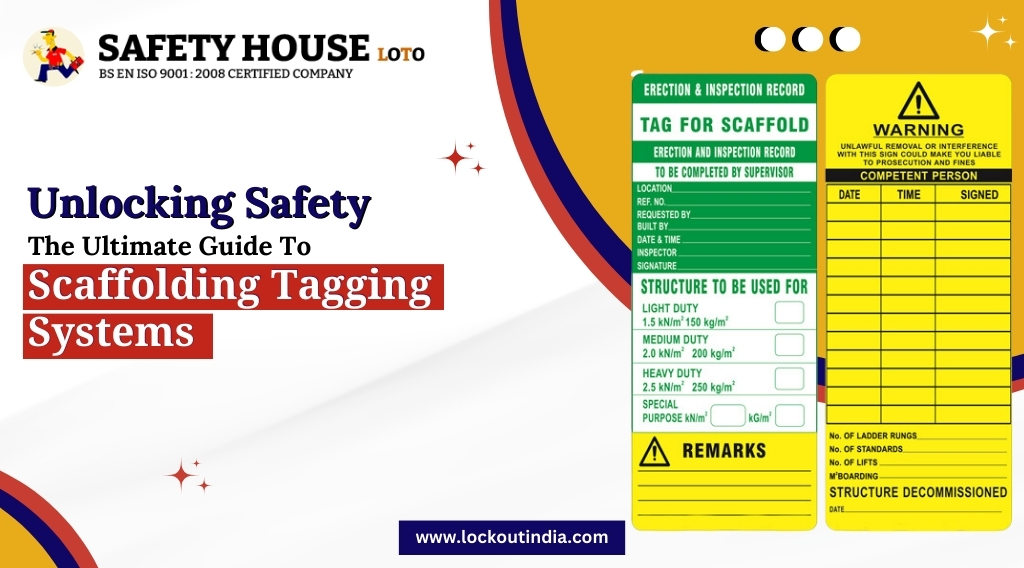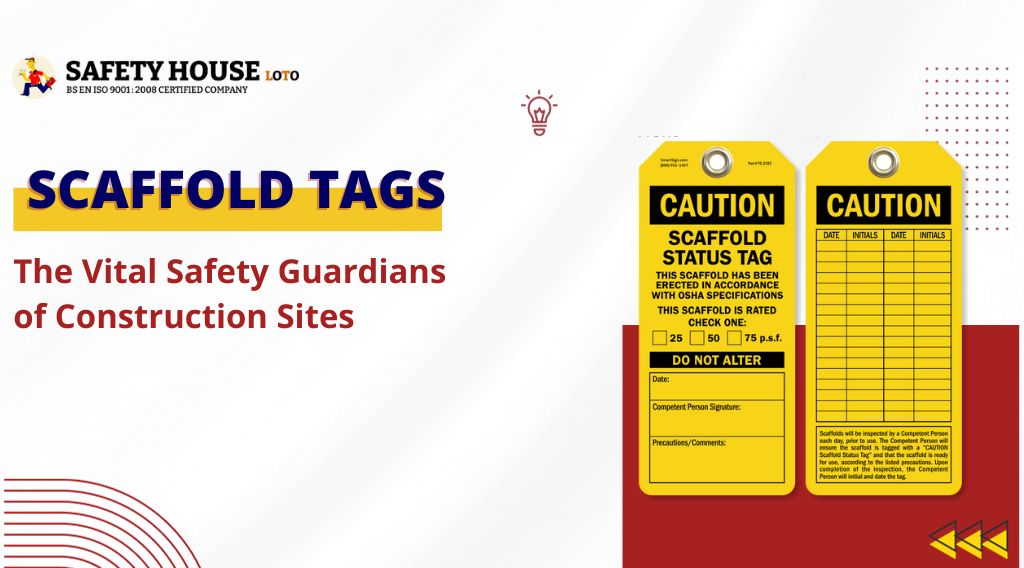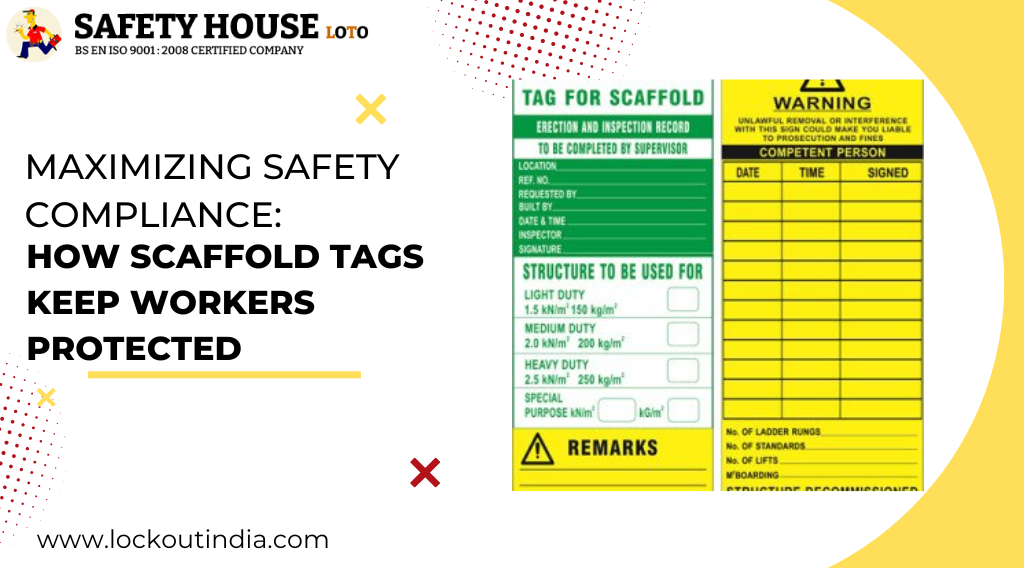
Unlocking Safety: The Ultimate Guide to Scaffolding Tagging Systems
Introduction:
In the realm of construction and industrial settings, safety is paramount. Scaffolding, a ubiquitous fixture in such environments, demands rigorous safety protocols to protect workers and prevent accidents. Enter scaffolding tagging systems, a vital component of safety procedures. In this comprehensive guide, we delve into the intricacies of scaffolding tag systems, their importance, implementation, and best practices.
What is a Scaffolding Tag?
A scaffolding tag is a visual indicator affixed to scaffolding structures, providing crucial information about its safety status and usage guidelines. Typically, these tags consist of color-coded segments and pertinent details such as inspection dates, safety precautions, and load-bearing capacities.
Importance of Scaffolding Tagging Systems:
- Enhanced Safety Awareness: Scaffolding tags serve as a constant reminder of safety protocols, fostering a culture of awareness among workers and supervisors.
- Compliance with Regulations: Regulatory bodies mandate the use of scaffolding tagging systems to ensure adherence to safety standards and regulations.
- Risk Mitigation: By clearly indicating the status of scaffolding structures, tags help identify potential hazards and mitigate risks before accidents occur.
- Efficient Maintenance: Regular inspections facilitated by scaffolding tags enable timely maintenance and repairs, prolonging the lifespan of scaffolding equipment.
- Accountability and Documentation: Tags provide a documented record of inspections, demonstrating compliance with safety regulations and liability in case of incidents.
Components of a Scaffolding Tag:
- Color-Coded Segments: Tags often feature color-coded segments to indicate the scaffolding’s safety status. Common colors include green for safe, yellow for caution, and red for unsafe.
- Inspection Details: Tags display essential information such as inspection dates, inspector signatures, and any identified issues or recommendations.
- Usage Guidelines: Instructions regarding maximum load capacities, prohibited activities, and safety precautions are prominently featured on scaffolding tags.
- Contact Information: Tags may include contact details for reporting safety concerns or seeking clarification on usage guidelines.
Implementing Scaffolding Tagging Systems:
- Training and Education: Ensure that all personnel involved in scaffolding operations receive comprehensive training on the significance of scaffolding tags and how to interpret them.
- Standardized Procedures: Develop standardized procedures for tagging scaffolding structures, including inspection frequencies, documentation requirements, and protocols for addressing identified issues.
- Quality Assurance: Regularly audit scaffolding tagging systems to verify compliance with established procedures and identify areas for improvement.
- Collaboration with Regulatory Bodies: Work closely with relevant regulatory bodies to stay abreast of updated safety regulations and ensure alignment with scaffolding tagging practices.
Best Practices for Scaffolding Tagging Systems:
- Frequent Inspections: Conduct regular inspections of scaffolding structures, adhering to predetermined schedules and documented procedures.
- Clear Communication: Ensure that scaffolding tags are prominently displayed and easily visible to workers, supervisors, and inspectors.
- Immediate Action on Red Tags: Red tags indicating unsafe conditions should prompt immediate corrective action, including cessation of work until issues are resolved.
- Documentation and Record-Keeping: Maintain detailed records of inspections, including dates, findings, corrective actions taken, and signatures of inspectors.
- Continuous Improvement: Solicit feedback from workers and inspectors to identify opportunities for enhancing the effectiveness of scaffolding tagging systems and safety protocols.
Conclusion:
In the dynamic landscape of construction and industrial environments, safety remains an indispensable priority. Scaffolding tagging systems, like those provided by Safety House Loto, serve as a cornerstone of safety protocols, providing essential information and visual cues to safeguard workers and prevent accidents. By understanding the importance, components, implementation strategies, and best practices of scaffolding tag systems, organizations can foster a culture of safety, compliance, and accountability. Unlock the potential of safety with robust scaffolding tagging systems from Safety House Loto, ensuring a secure and productive work environment for all.

Scaffold Tags: The Vital Safety Guardians of Construction Sites
Construction sites are bustling hubs of activity, but amidst the controlled chaos, safety remains paramount. Workers navigate a complex landscape of materials, equipment, and potential hazards, and every step must be taken to ensure their well-being. In this intricate safety ecosystem, scaffold tags play a crucial role, silently standing guard as vital safety guardians.
What are Scaffold Tags?
Scaffold tags are small, yet potent safety devices attached to scaffolding components. They serve as visual indicators, communicating crucial information about the scaffold’s load capacity, weight limitations, and inspection status. Typically made of durable materials like weatherproof plastic or metal, scaffold tags come in various colors and designs to easily convey specific messages.
Why are Scaffold Tags Important?
The importance of tags cannot be overstated. They function as the first line of defense against potential accidents and injuries on construction sites. Here’s how they contribute to enhanced safety:
- Clear and concise communication: Scaffold tags provide instant visual information about the scaffold’s capabilities and limitations. This eliminates any ambiguity or confusion that could lead to misuse or overloading.
- Promotes adherence to safety regulations: Different tag colors and symbols correspond to specific safety standards and regulations. This ensures that workers are readily aware of the guidelines they need to follow while working on the scaffolding.
- Facilitates regular inspections: Scaffold tags often include spaces to record inspection dates and findings. This promotes a culture of regular maintenance and timely identification of potential hazards.
- Raises safety awareness: The constant presence of scaffold tags is a constant reminder of the importance of safety. This keeps workers vigilant and reinforces safe practices throughout the construction process.
Types of Scaffold Tags
Scaffold tags come in a variety of types, each serving a specific purpose. Some of the most common ones include:
- Load capacity tags specify the maximum weight the scaffold can safely support. Exceeding this limit can lead to catastrophic failure, hence the critical role of these tags.
- Inspection tags: These tags document the date of the last scaffold inspection and any things to note that were identified. Regular inspections are essential for maintaining the integrity of the scaffolding.
- Do not climb tags: These tags serve as a clear warning, prohibiting unauthorized from climbing on the scaffolding. This helps to prevent falls and other accidents.
- Out-of-order tags: These tags identify scaffolding components that are defective or unsafe for use. This prevents workers from inadvertently using damaged equipment and incurring risks.
Choosing the Right Safety Tags Manufacturer
With the safety of workers at stake, choosing the right scaffold tag manufacturer is crucial. Look for a manufacturer that:
- Uses high-quality materials: The tags should be durable and weatherproof to withstand harsh construction site conditions.
- Offers a variety of tags: The manufacturer should cater to diverse needs with a range of tags addressing different safety aspects.
- Complies with safety regulations: Ensure the tags comply with relevant safety standards and regulations in your region.
- Provides clear and easy-to-understand tags: The information on the tags should be unambiguous and readily understandable by workers.
Investing in Safety, Investing in Lives
Scaffold tags may seem like small,ordinity objects, but their impact on construction site safety is undeniable. By providing clear and concise information, they empower workers to make informed decisions and navigate the complexities of scaffolding with confidence. Remember, safety is not an expense; it’s an investment in the well-being of your workforce and the long-term success of your construction projects. So, prioritize scaffold tags as vital safety guardians, and watch your construction site transform into a haven of safety and productivity.
Additional Tips for Scaffold Safety
- Always follow manufacturer instructions for assembling and using scaffolding.
- Never overload a scaffold beyond its rated capacity.
- Inspect scaffolds regularly for damage or defects.
- Wear appropriate personal protective equipment (PPE) when working on or around scaffolding.
- Train workers on proper scaffold safety procedures.
By following these tips and making scaffold tags an integral part of your safety protocols, you can create a safer construction site for everyone involved.
I hope this blog post has been informative and insightful. If you have any questions or suggestions, please feel free to leave a comment below.

Maximizing Safety Compliance: How Scaffold Tags Keep Workers Protected?
When it comes to working on scaffolds, safety should always be the top priority. However, accidents can still happen despite having strict safety guidelines in place. This is where scaffold tags come into play! These small but powerful tags are essential for maximizing safety compliance and keeping workers protected while working at heights. In this blog post, we’ll delve deeper into what scaffold tags are, how they improve safety measures, their benefits and how to use them effectively to ensure optimal compliance. So grab a cup of coffee and let’s get started!
What Are Scaffold Tags?
Scaffold tags are small identification tags that are attached to scaffolding structures. They contain important information about the scaffold, including its inspection history, weight limitations, safety guidelines and more.
These tags come in various colors, each representing a specific meaning or message. For instance, red may indicate that the scaffold is not safe to use and requires repair work before it can be used again.
In addition to providing essential information about the scaffold structure itself, these tags also play an integral role in enhancing worksite safety measures. They serve as visual reminders of necessary precautions and restrictions that should be followed while working on or around scaffolds.
Furthermore, they help ensure compliance with relevant industry regulations such as OSHA (Occupational Safety and Health Administration) standards for workplace safety.
Scaffold tags are critical components of any scaffolding system and play a vital role in keeping workers safe at all times when working at heights.
How Do Scaffold Tags Improve Safety?
Scaffold tags are an essential tool for improving safety in construction sites that involve scaffolding. They help ensure that workers remain safe while working at heights and prevent accidents from occurring.
One way scaffold tags improve safety is by providing clear instructions to workers about the status of the scaffold. The tag will indicate whether the scaffold has been erected properly, inspected and deemed safe to use or if it’s under repair or maintenance.
Another advantage of using scaffold tags is their ability to communicate important information such as weight limits, maximum height restrictions, and other critical details related to the specific job site. This ensures that workers are aware of all relevant information before they start working on a particular project.
Additionally, Scaffold tags provide visual cues that attract attention and remind workers always to be vigilant when using scaffolding equipment. Workers can easily spot a bright red tag hanging from a scaffold warning them not to use it; this helps prevent accidents from happening due to negligence or oversight.
Using Scaffold Tags improves safety compliance on job sites significantly. By providing clear communication regarding pertinent details about scaffolds’ conditions, weight limits, heights restrictions among others tasks become safer and more efficient for everyone involved in construction projects involving Scaffolds.
What Are The Benefits Of Using Scaffold Tags?
Using scaffold tags on construction sites can bring numerous benefits to workers and employers alike. It allows for easy identification of the current status of a scaffold. This means that every worker who needs to use it will be aware if it is safe to do so or not. Additionally, by using these tags, workers can quickly see when the last inspection was carried out and who performed it.
Another benefit of using scaffold tags is that they help prevent unauthorized access. With a clear “Do Not Use” message displayed on the tag when necessary, only those with proper training and authorization are allowed to work on the scaffolding structure.
Furthermore, having effective safety measures in place like scaffold tags will reduce accidents rates significantly while improving overall safety conditions at work. In turn, this leads to increased productivity since less time is lost due to injuries or non-compliance issues.
Using scaffold tags demonstrates compliance with OSHA regulations which could prevent costly fines and legal battles down the line. By showing an active commitment towards workplace safety through such practices as utilizing lockout tagout products like Scaffolds Tags Scaffolding Tags – companies can avoid potentially expensive penalties while keeping their employees safe from harm.
How To Use Scaffold Tags Effectively?
Using scaffold tags effectively is crucial for ensuring worker safety on construction sites. Here are some tips to help you use them properly:
1. Follow manufacturer instructions: Always read and follow the manufacturer’s instructions carefully when using scaffold tags.
2. Properly attach the tag: Make sure the tag is securely attached to the scaffolding frame or structure in a visible location that can be easily seen by workers.
3. Update information regularly: Keep your scaffold tags up-to-date by updating important information such as inspection dates, load limits, and other relevant details.
4. Use clear language and icons: Use clear, easy-to-understand language and icons on your scaffold tags so that everyone who sees it can understand its meaning.
5. Train workers about proper usage: Ensure all workers are trained on how to correctly use scaffold tags and what each element means before they begin working on a site with scaffolding present.
By following these tips, you can ensure that your team is using scaffold tags effectively, thus minimizing risks of accidents or injuries on construction sites while staying compliant with safety regulations.
Scaffold Tag Compliance Best Practices
To ensure the safety of workers, it is crucial to adhere to scaffold tag compliance best practices. Here are some tips for effective compliance:
Always use durable tags that cannot easily be damaged or removed. The tag should also be clearly visible and capable of withstanding harsh environmental conditions.
Always make sure that the correct information is included on the tag such as date of inspection, load capacity and any other relevant details.
Implement a tagging system where tags are assigned to specific scaffolds and workers. This ensures accountability and makes it easier to identify when a scaffold requires attention.
Fourthly, develop a routine inspection schedule for both internal inspections by staff members as well as external inspections carried out by professionals.
Train your employees on how to read scaffold tags so they can identify if there are any issues with the structure that require attention before proceeding with work activities.
By adhering to these best practices in scaffold tag compliance, you will help keep your workplace safe for all employees who use scaffolding structures while performing their job duties.
Conclusion
Scaffold tags are an essential tool in ensuring worker safety and compliance with industry regulations. By using scaffold tags effectively, workers can easily identify the status of a scaffold and take necessary precautions to avoid accidents.
Remember, when it comes to scaffolding safety, there is no room for shortcuts or complacency. Therefore, always follow best practices for maintaining compliance with lockout tagout products like scaffold tags.
By doing so, you will not only ensure a safe working environment but also demonstrate your commitment to workplace safety and protecting your employees from harm. So let’s make sure that we use these simple yet effective tools wisely in order to maximize our efforts toward workplace safety!
Checkout Our Popular Products:
- Key box
- Valve lockout
- Loto Kit
- Lockout supplier


